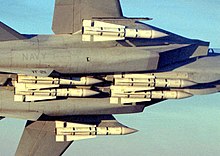AIM-54 Phoenix
| AIM-54 Phoenix | |
|---|---|

Six AIM-54 Phoenix missiles seen mounted on the belly and wing gloves of a U.S. Navy F-14B in January 1989
|
|
| Type | Long-range air-to-air missile |
| Place of origin | United States |
| Service history | |
| In service | 1974–2004 |
| Used by |
United States Navy (former) Iranian Air Force |
| Production history | |
| Manufacturer |
Hughes Aircraft Company Raytheon Corporation |
| Unit cost | US$477,131 |
| Produced | 1966 |
| Specifications | |
| Weight | 1,000–1,040 lb (450–470 kg) |
| Length | 13 ft (4.0 m) |
| Diameter | 15 in (380 mm) |
| Warhead | 135 lb (61 kg), high explosive |
|
Detonation
mechanism |
Proximity fuze |
|
|
|
| Engine | Solid propellant rocket motor |
| Wingspan | 3 ft (910 mm) |
|
Operational
range |
100 nmi (190 km) |
| Flight ceiling | 100,000 ft (30 km) |
| Flight altitude | 80,000 ft (24 km) |
| Speed | Mach 5 |
|
Guidance
system |
Semi-active radar homing and terminal phase active radar homing |
|
Launch
platform |
Grumman F-14 Tomcat |
The AIM-54 Phoenix is a radar-guided, long-range air-to-air missile (AAM), carried in clusters of up to six missiles on the Grumman F-14 Tomcat, its only operational launch platform. The Phoenix was the United States' only long-range air-to-air missile. The combination of Phoenix missile and the AN/AWG-9 guidance radar was the first aerial weapons system that could simultaneously engage multiple targets. Both the missile and the aircraft were used by the United States Navy and are now retired, the AIM-54 Phoenix in 2004 and the F-14 in 2006. They were replaced by the shorter-range AIM-120 AMRAAM, employed on the F/A-18 Hornet and F/A-18E/F Super Hornet. Following the retirement of the F-14 by the U.S. Navy, the weapon's only current operator is the Islamic Republic of Iran Air Force. Brevity code "Fox Three" was used when firing the AIM-54.
Since 1951, the Navy faced the initial threat from the Tupolev Tu-4K 'Bull' carryinganti-ship missiles. Eventually, during the height of the Cold War, the threat would have expanded into regimental-size raids of Tu-16 Badger and Tu-22M Backfire bombers equipped with low-flying, long-range, high-speed, nuclear-armed cruise missiles and considerable electronic countermeasures (ECM) of various types.
The Navy would require a long-range, long-endurance interceptor aircraft to defend carrier battle groups against this threat. The proposed F6D Missileer was intended to fulfill this mission and oppose the attack far from the fleet it was defending. The weapon needed for interceptor aircraft, the Bendix AAM-N-10 Eagle, was to be an air-to-air missile of unprecedented range when compared to contemporary AIM-7 Sparrow missiles. It would work together with Westinghouse AN/APQ-81 radar. The Missileer project was cancelled in December 1960.
...
Wikipedia
